A Review of Reactor Designs for Hydrogen Storage in Clathrate Hydrates
Abstract
:1. Introduction
- (1)
- Pressure and temperature conditions for the formation and storage of H2 hydrates have to be optimised. Ideally, the pressure should be less than 10 MPa and the temperature around 0 °C.
- (2)
- The H2-storage capacity should be as high as possible (ideally approaching ~5 wt%).
- (3)
- Any hydrate promoters should be eco-friendly and cheap.
2. Hydrate-Formation Technologies
- o
- Gas dispersion introduced in water continuous phase, or;
- o
- Liquid dispersion, which involves introducing water droplets in a high pressure gas chamber.
2.1. Stirred-Tank Reactor
- As slurry thickens the energy cost of stirring increases [24].
- Additional work required for hydrate/slurry separation, for hydrate packing in a storage vessel.
- Considerable amounts of interstitial water will remain between hydrate grains.
- Hindered scale-up. The required agitation power increases with the 5th power of the impeller size [25].
2.2. Bubble Forming
- An enhanced gas and liquid mixing characteristics and mass transfer.
- The possibility of using an external heat exchanger for controlling the liquid’s temperature to avoid the disadvantages of using internal cooling coil installations.
- Gas circulation provides the optimum use of the gas and eliminate the need for any additional gas compression step.
- Easier operation and less sealing problems at high pressure due to the absence of moving parts in the design.
2.3. Water-In-Oil Emulsion
2.4. Fixed-Bed Reactor
2.5. Unidirectional Growth
2.6. Spraying Reactor
- Gas-supply: To supply gas and maintain the pressure.
- Refrigeration system: To keep the reactor at low temperature by dissipating the released latent heat during hydrate formation.
- Reactor chamber: The hydrate-formation chamber.
- Spraying system: water sprays as small particles into the gas phase
- Data-logging system: Pressure, temperature and mass flow will be recorded during the reaction time.
2.7. High-Pressure Optical Cell
2.8. Hydrate-Storage Designs
3. Conclusions
- -
- Laboratory work from micro to macro scales: On a molecular and micro scale, it would be highly desirable to determine the influence of additives on H2-hydrate formation kinetics, in addition to thermodynamic properties, structure, composition, and cage occupancy of the resulting hydrate phase; the molecular-migration behaviour of the H2 molecules in the hydrate phase requires detailed study. Also, the interaction between additives and the hydrate phase needs to be investigated. Various analytical methods, such as Raman spectroscopy, differential-scanning calorimetry, and X-ray diffraction need to be considered. On a medium to large scale, the efficiency of H2-hydrate formation with respect to H2-storage capacity, hydrate-formation kinetics, as well as phase equilibrium, require investigation using high-pressure autoclaves. This background experimental data could, and, indeed, should, be used for important mechanistic and parametric modelling, to increase our level of insight into fundamentals of hydrate formation in the context of scaled-up hydrate reactors.
- -
- Molecular-dynamics simulation: Based on experimental data, molecular-dynamics (MD) simulations need to be performed to ascertain and elucidate crystallisation mechanisms of hydrogen hydrates. Indeed, insights from experiments can be used to inform and parameterise force-fields for MD, so as to allow MD to replicate as closely as possible experimental findings. Based on such insights into molecular mechanisms, it will be possible to assess free-energy profiles for transitions to the hydrate state, as well as to restructuring of water in the hydration layers around promotors and additives.
Author Contributions
Funding
Institutional Review Board Statement
Informed Consent Statement
Data-Availability Statement
Conflicts of Interest
References
- Crabtree, G.W.; Dresselhaus, M.S.; Buchanan, M.V. The Hydrogen Economy. Phys. Today 2004, 57, 39–44. [Google Scholar] [CrossRef]
- Modisha, P.M.; Ouma, C.N.M.; Garidzirai, R.; Wasserscheid, P.; Bessarabov, D. The Prospect of Hydrogen Storage Using Liquid Organic Hydrogen Carriers. Energy Fuels 2019, 33, 2778–2796. [Google Scholar] [CrossRef]
- Stackelberg, M.V. Feste gashydrate. Naturwissenschaften 1949, 36, 327–333. [Google Scholar] [CrossRef]
- Mao, W.L.; Mao, H.-K.; Goncharov, A.F.; Struzhkin, V.V.; Guo, Q.; Hu, J.; Shu, J.; Hemley, R.J.; Somayazulu, M.; Zhao, Y. Hydrogen Clusters in Clathrate Hydrate. Science 2002, 297, 2247–2249. [Google Scholar] [CrossRef]
- Lee, H.; Lee, J.-W.; Kim, D.Y.; Park, J.; Seo, Y.-T.; Zeng, H.; Moudrakovski, I.; Ratcliffe, C.I.; Ripmeester, J.A. Tuning clathrate hydrates for hydrogen storage. Nat. Cell Biol. 2005, 434, 743–746. [Google Scholar] [CrossRef]
- Zhong, J.-R.; Chen, L.-T.; Liu, T.-C.; Zeng, X.-Y.; Sun, Y.-F.; Sun, C.-Y.; Liu, B.; Chen, G.-J.; Ripmeester, J.A. Sieving of Hydrogen-Containing Gas Mixtures with Tetrahydrofuran Hydrate. J. Phys. Chem. C 2017, 121, 27822–27829. [Google Scholar] [CrossRef]
- Prasad, P.S.R.; Sugahara, T.; Sum, A.K.; Sloan, E.D.; Koh, C.A. Hydrogen Storage in Double Clathrates withtert-Butylamine. J. Phys. Chem. A 2009, 113, 6540–6543. [Google Scholar] [CrossRef]
- Veluswamy, H.P.; Kumar, R.; Linga, P. Hydrogen storage in clathrate hydrates: Current state of the art and future directions. Appl. Energy 2014, 122, 112–132. [Google Scholar] [CrossRef]
- Grim, R.G.; Barnes, B.C.; Lafond, P.G.; Kockelmann, W.A.; Keen, D.A.; Soper, A.K.; Hiratsuka, M.; Yasuoka, K.; Koh, C.A.; Sum, A.K. Observation of Interstitial Molecular Hydrogen in Clathrate Hydrates. Angew. Chem. Int. Ed. 2014, 53, 10710–10713. [Google Scholar] [CrossRef]
- Ahn, Y.-H.; Moon, S.; Koh, D.-Y.; Hong, S.; Lee, H.; Lee, J.W.; Park, Y. One-step formation of hydrogen clusters in clathrate hydrates stabilized via natural gas blending. Energy Storage Mater. 2020, 24, 655–661. [Google Scholar] [CrossRef]
- Nguyen, T.T.; Pétuya, C.; Talaga, D.; Desmedt, A. Promoting the Insertion of Molecular Hydrogen in Tetrahydrofuran Hydrate With the Help of Acidic Additives. Front. Chem. 2020, 8, 550862. [Google Scholar] [CrossRef] [PubMed]
- Desmedt, A.; Martin-Gondre, L.; Nguyen, T.T.; Pétuya, C.; Barandiaran, L.; Babot, O.; Toupance, T.; Grim, R.G.; Sum, A.K. Modifying the Flexibility of Water Cages by Co-Including Acidic Species within Clathrate Hydrate. J. Phys. Chem. C 2015, 119, 8904–8911. [Google Scholar] [CrossRef]
- Trueba, A.T.; Radovic, I.; Zevenbergen, J.F.; Kroon, M.C.; Peters, C.C. Kinetics measurements and in situ Raman spectroscopy of formation of hydrogen–tetrabutylammonium bromide semi-hydrates. Int. J. Hydrogen Energy 2012, 37, 5790–5797. [Google Scholar] [CrossRef]
- Trueba, A.T.; Radovic, I.; Zevenbergen, J.F.; Peters, C.C.; Kroon, M.C. Kinetic measurements and in situ Raman spectroscopy study of the formation of TBAF semi-hydrates with hydrogen and carbon dioxide. Int. J. Hydrogen Energy 2013, 38, 7326–7334. [Google Scholar] [CrossRef]
- Veluswamy, H.P.; Linga, P. Macroscopic kinetics of hydrate formation of mixed hydrates of hydrogen/tetrahydrofuran for hydrogen storage. Int. J. Hydrogen Energy 2013, 38, 4587–4596. [Google Scholar] [CrossRef]
- Malet-Sanz, L.; Susanne, F. Continuous Flow Synthesis. A Pharma Perspective. J. Med. Chem. 2012, 55, 4062–4098. [Google Scholar] [CrossRef]
- Razzaq, T.; Kappe, C.O. Continuous Flow Organic Synthesis under High-Temperature/Pressure Conditions. Chem. Asian J. 2010, 5, 1274–1289. [Google Scholar] [CrossRef]
- Wegner, J.; Ceylan, S.; Kirschning, A. Flow Chemistry—A Key Enabling Technology for (Multistep) Organic Synthesis. Adv. Synth. Catal. 2012, 354, 17–57. [Google Scholar] [CrossRef]
- Tortoioli, S.; Friedli, A.; Prud’Homme, A.; Richard-Bildstein, S.; Kohler, P.; Abele, S.; Vilé, G. Development of an efficient and sustainable synthesis of 2-(3-methyl-1H-1,2,4-triazol-1-yl) acetic acid under continuous-flow conditions. Green Chem. 2020, 22, 3748–3758. [Google Scholar] [CrossRef] [Green Version]
- Wiles, C.; Watts, P. Continuous flow reactors: A perspective. Green Chem. 2012, 14, 38–54. [Google Scholar] [CrossRef]
- Porta, R.; Benaglia, M.; Puglisi, A. Flow Chemistry: Recent Developments in the Synthesis of Pharmaceutical Products. Org. Process. Res. Dev. 2016, 20, 2–25. [Google Scholar] [CrossRef] [Green Version]
- Jones, R.V.; Godorhazy, L.; Varga, N.; Szalay, D.; Urge, A.L.; Darvas, F. Continuous-Flow High Pressure Hydrogenation Reactor for Optimization and High-Throughput Synthesis. J. Comb. Chem. 2006, 8, 110–116. [Google Scholar] [CrossRef] [PubMed]
- Hould, N.; Elanany, M.S.; Aleisa, R.M.; Al-Majnouni, K.A.; Al-Malki, A.; Abba, I. Evaluating polymeric inhibitors of ethane clathrate hydrates. J. Nat. Gas Sci. Eng. 2015, 24, 543–549. [Google Scholar] [CrossRef]
- Vysniauskas, A.; Bishnoi, P. A kinetic study of methane hydrate formation. Chem. Eng. Sci. 1983, 38, 1061–1072. [Google Scholar] [CrossRef]
- Tang, L.-G.; Li, X.-S.; Feng, Z.-P.; Lin, A.Y.-L.; Fan, S.-S. Natural Gas Hydrate Formation in an Ejector Loop Reactor: Preliminary Study. Ind. Eng. Chem. Res. 2006, 45, 7934–7940. [Google Scholar] [CrossRef]
- Takahashi, M.; Kawamura, T.; Yamamoto, Y.; Ohnari, H.; Himuro, S.; Shakutsui, H. Effect of Shrinking Microbubble on Gas Hydrate Formation. J. Phys. Chem. B 2003, 107, 2171–2173. [Google Scholar] [CrossRef]
- Havelka, P.; Linek, V.; Sinkule, J.; Zahradník, J.; Fialova, M. Effect of the ejector configuration on the gas suction rate and gas hold-up in ejector loop reactors. Chem. Eng. Sci. 1997, 52, 1701–1713. [Google Scholar] [CrossRef]
- Xin, Y.; Zhang, J.; He, Y.; Wang, C. Modelling and experimental study of hydrate formation kinetics of natural gas-water-surfactant system in a multi-tube bubble column reactor. Can. J. Chem. Eng. 2019, 97, 2765–2776. [Google Scholar] [CrossRef]
- You, R.; Li, H.; Tao, Z. Experimental investigation on two-dimensional heat transfer and secondary flow in a rotating smooth channel. Int. J. Heat Mass Transf. 2017, 113, 342–353. [Google Scholar] [CrossRef]
- Wei, K.; Tao, Z.; Wu, H.; Xu, G.; Li, H.; You, R. Interaction between the primary flow fields and the secondary flow fields under rotating condition. Exp. Therm. Fluid Sci. 2017, 84, 217–230. [Google Scholar] [CrossRef]
- Zhai, Y.; Li, Z.; Wang, H.; Xie, G. Analysis of field synergy principle and the relationship between secondary flow and heat transfer in double-layered microchannels with cavities and ribs. Int. J. Heat Mass Transf. 2016, 101, 190–197. [Google Scholar] [CrossRef]
- Guo, J.; Huai, X. Numerical investigation of helically coiled tube from the viewpoint of field synergy principle. Appl. Therm. Eng. 2016, 98, 137–143. [Google Scholar] [CrossRef]
- Guo, J.; Xu, M.; Cheng, L. Numerical investigations of circular tube fitted with helical screw-tape inserts from the viewpoint of field synergy principle. Chem. Eng. Process. Process. Intensif. 2010, 49, 410–417. [Google Scholar] [CrossRef]
- Ghaani, M.R.; Kusalik, P.G.; English, N.J. Massive generation of metastable bulk nanobubbles in water by external electric fields. Sci. Adv. 2020, 6, eaaz0094. [Google Scholar] [CrossRef] [PubMed] [Green Version]
- Liu, H.; Zhan, S.; Li, R.; Liu, Y.; Guo, P.; Wang, Z.; Du, J.; Wen, Y.; Dai, P.; Liao, H. High-efficiency natural-gas storage method involving formation of gas hydrate in water/oil-cyclopentane emulsion. Chem. Eng. J. 2020, 400, 125369. [Google Scholar] [CrossRef]
- Liu, H.; Wang, J.; Chen, G.; Liu, B.; Dandekar, A.; Wang, B.; Zhang, X.; Sun, C.; Ma, Q.-L. High-efficiency separation of a CO2/H2 mixture via hydrate formation in W/O emulsions in the presence of cyclopentane and TBAB. Int. J. Hydrogen Energy 2014, 39, 7910–7918. [Google Scholar] [CrossRef]
- Liu, H.; Mu, L.; Wang, B.; Liu, B.; Wang, J.; Zhang, X.; Sun, C.; Chen, J.; Jia, M.; Chen, G. Separation of ethylene from refinery dry gas via forming hydrate in w/o dispersion system. Sep. Purif. Technol. 2013, 116, 342–350. [Google Scholar] [CrossRef]
- Liu, H.; Mu, L.; Liu, B.; Zhang, X.; Wang, J.; Wang, B.; Sun, C.; Yang, L.; Wang, H.; Xiao, P.; et al. Experimental Studies of the Separation of C2 Compounds from CH4 + C2H4 + C2H6 + N2 Gas Mixtures by an Absorption–Hydration Hybrid Method. Ind. Eng. Chem. Res. 2013, 52, 2707–2713. [Google Scholar] [CrossRef]
- Di Profio, P.; Canale, V.; Germani, R.; Arca, S.; Fontana, A. Reverse micelles enhance the formation of clathrate hydrates of hydrogen. J. Colloid Interface Sci. 2018, 516, 224–231. [Google Scholar] [CrossRef]
- Greaves, D.; Boxall, J.; Mulligan, J.; Sloan, E.D.; Koh, C.A. Hydrate formation from high water content-crude oil emulsions. Chem. Eng. Sci. 2008, 63, 4570–4579. [Google Scholar] [CrossRef]
- Di Profio, P.; Arca, S.; Rossi, F.; Filipponi, M. Comparison of hydrogen hydrates with existing hydrogen storage technologies: Energetic and economic evaluations. Int. J. Hydrogen Energy 2009, 34, 9173–9180. [Google Scholar] [CrossRef]
- Murakami, T.; Kuritsuka, H.; Fujii, H.; Mori, Y.H. Forming a Structure-H Hydrate Using Water and Methylcyclohexane Jets Impinging on Each Other in a Methane Atmosphere. Energy Fuels 2009, 23, 1619–1625. [Google Scholar] [CrossRef]
- Khokhar, A.; Gudmundsson, J.; Sloan, E. Gas storage in structure H hydrates. Fluid Phase Equilibria 1998, 150–151, 383–392. [Google Scholar] [CrossRef]
- Mori, Y.H.; Nagai, K.; Funaba, H.; Komotori, K. Cooling of Freely Falling Liquid Drops with a Shell of an Immiscible Volatile Liquid. J. Heat Transf. 1981, 103, 508–513. [Google Scholar] [CrossRef]
- Adeyemo, A.; Kumar, R.; Linga, P.; Ripmeester, J.; Englezos, P. Capture of carbon dioxide from flue or fuel gas mixtures by clathrate crystallization in a silica gel column. Int. J. Greenh. Gas Control. 2010, 4, 478–485. [Google Scholar] [CrossRef] [Green Version]
- Babu, P.; Kumar, R.; Linga, P. Pre-combustion capture of carbon dioxide in a fixed bed reactor using the clathrate hydrate process. Energy 2013, 50, 364–373. [Google Scholar] [CrossRef]
- Kumar, A.; Kumar, R. Role of Metallic Packing and Kinetic Promoter in Designing a Hydrate-Based Gas Separation Process. Energy Fuels 2015, 29, 4463–4471. [Google Scholar] [CrossRef]
- Kumar, A.; Sakpal, T.; Linga, P.; Kumar, R. Influence of contact medium and surfactants on carbon dioxide clathrate hydrate kinetics. Fuel 2013, 105, 664–671. [Google Scholar] [CrossRef]
- Park, S.; Lee, S.; Lee, Y.; Lee, Y.; Seo, Y. Hydrate-based pre-combustion capture of carbon dioxide in the presence of a thermodynamic promoter and porous silica gels. Int. J. Greenh. Gas Control. 2013, 14, 193–199. [Google Scholar] [CrossRef]
- Kang, S.-P.; Lee, J.; Seo, Y. Pre-combustion capture of CO2 by gas hydrate formation in silica gel pore structure. Chem. Eng. J. 2013, 218, 126–132. [Google Scholar] [CrossRef]
- Song, Y.; Wang, X.; Yang, M.; Jiang, L.; Liu, Y.; Dou, B.; Zhao, J.; Wang, S. Study of Selected Factors Affecting Hydrate-Based Carbon Dioxide Separation from Simulated Fuel Gas in Porous Media. Energy Fuels 2013, 27, 3341–3348. [Google Scholar] [CrossRef]
- Babu, P.; Linga, P.; Kumar, R.; Englezos, P. A review of the hydrate based gas separation (HBGS) process for carbon dioxide pre-combustion capture. Energy 2015, 85, 261–279. [Google Scholar] [CrossRef]
- Muraoka, M.; Susuki, N.; Yamamoto, Y. Evaluation of the performance of kinetic inhibitors for clathrate hydrate using unidirectional growth apparatus. RSC Adv. 2016, 6, 63880–63885. [Google Scholar] [CrossRef] [Green Version]
- Ohmura, R.; Kashiwazaki, S.; Shiota, S.; Tsuji, H.; Mori, Y.H. Structure-I and Structure-H Hydrate Formation Using Water Spraying. Energy Fuels 2002, 16, 1141–1147. [Google Scholar] [CrossRef]
- Tsuji, H.; Ohmura, R.; Mori, Y.H. Forming Structure-H Hydrates Using Water Spraying in Methane Gas: Effects of Chemical Species of Large-Molecule Guest Substances. Energy Fuels 2004, 18, 418–424. [Google Scholar] [CrossRef]
- Rossi, F.; Filipponi, M.; Castellani, B. Investigation on a novel reactor for gas hydrate production. Appl. Energy 2012, 99, 167–172. [Google Scholar] [CrossRef]
- Li, G.; Liu, D.; Xie, Y.; Xiao, Y. Study on Effect Factors for CO2Hydrate Rapid Formation in a Water-Spraying Apparatus. Energy Fuels 2010, 24, 4590–4597. [Google Scholar] [CrossRef]
- Fukumoto, K.; Tobe, J.-I.; Ohmura, R.; Mori, Y.H. Hydrate formation using water spraying in a hydrophobic gas: A preliminary study. AIChE J. 2001, 47, 1899–1904. [Google Scholar] [CrossRef]
- Matsuda, S.; Tsuda, H.; Mori, Y.H. Hydrate formation using water spraying onto a cooled solid surface in a guest gas. AIChE J. 2006, 52, 2978–2987. [Google Scholar] [CrossRef]
- Schicks, J.M.; Pan, M.; Giese, R.; Poser, M.; Ismail, N.A.; Luzi-Helbing, M.; Bleisteiner, B.; Lenz, C. A new high-pressure cell for systematic in situ investigations of micro-scale processes in gas hydrates using confocal micro-Raman spectroscopy. Rev. Sci. Instrum. 2020, 91, 115103. [Google Scholar] [CrossRef]
- Schicks, J.M.; Ripmeester, J.A. The Coexistence of Two Different Methane Hydrate Phases under Moderate Pressure and Temperature Conditions: Kinetic versus Thermodynamic Products. Angew. Chem. Int. Ed. 2004, 43, 3310–3313. [Google Scholar] [CrossRef] [PubMed]
- Cai, J.; Tao, Y.-Q.; Von Solms, N.; Xu, C.-G.; Chen, Z.-Y.; Li, X.-S. Experimental studies on hydrogen hydrate with tetrahydrofuran by differential scanning calorimeter and in-situ Raman. Appl. Energy 2019, 243, 1–9. [Google Scholar] [CrossRef]
- Ziparo, C.; Giannasi, A.; Ulivi, L.; Zoppi, M. Raman spectroscopy study of molecular hydrogen solubility in water at high pressure. Int. J. Hydrogen Energy 2011, 36, 7951–7955. [Google Scholar] [CrossRef]
- Sakamoto, J.; Hashimoto, S.; Tsuda, T.; Sugahara, T.; Inoue, Y.; Ohgaki, K. Thermodynamic and Raman spectroscopic studies on hydrogen+tetra-n-butyl ammonium fluoride semi-clathrate hydrates. Chem. Eng. Sci. 2008, 63, 5789–5794. [Google Scholar] [CrossRef]
- Cai, J.; Yan, R.; Xu, C.-G.; Chen, Z.-Y.; Li, X.-S. Formation and Dissociation Behavior Studies of Hydrogen Hydrate in the presence of Tetrahydrofuran by using High Pressure DSC. Energy Procedia 2019, 158, 5149–5155. [Google Scholar] [CrossRef]
- Shibata, T.; Yamachi, H.; Ohmura, R.; Mori, Y.H. Engineering investigation of hydrogen storage in the form of a clathrate hydrate: Conceptual designs of underground hydrate-storage silos. Int. J. Hydrogen Energy 2012, 37, 7612–7623. [Google Scholar] [CrossRef]
- Ozaki, M.; Tomura, S.; Ohmura, R.; Mori, Y.H. Comparative study of large-scale hydrogen storage technologies: Is hydrate-based storage at advantage over existing technologies? Int. J. Hydrogen Energy 2014, 39, 3327–3341. [Google Scholar] [CrossRef]
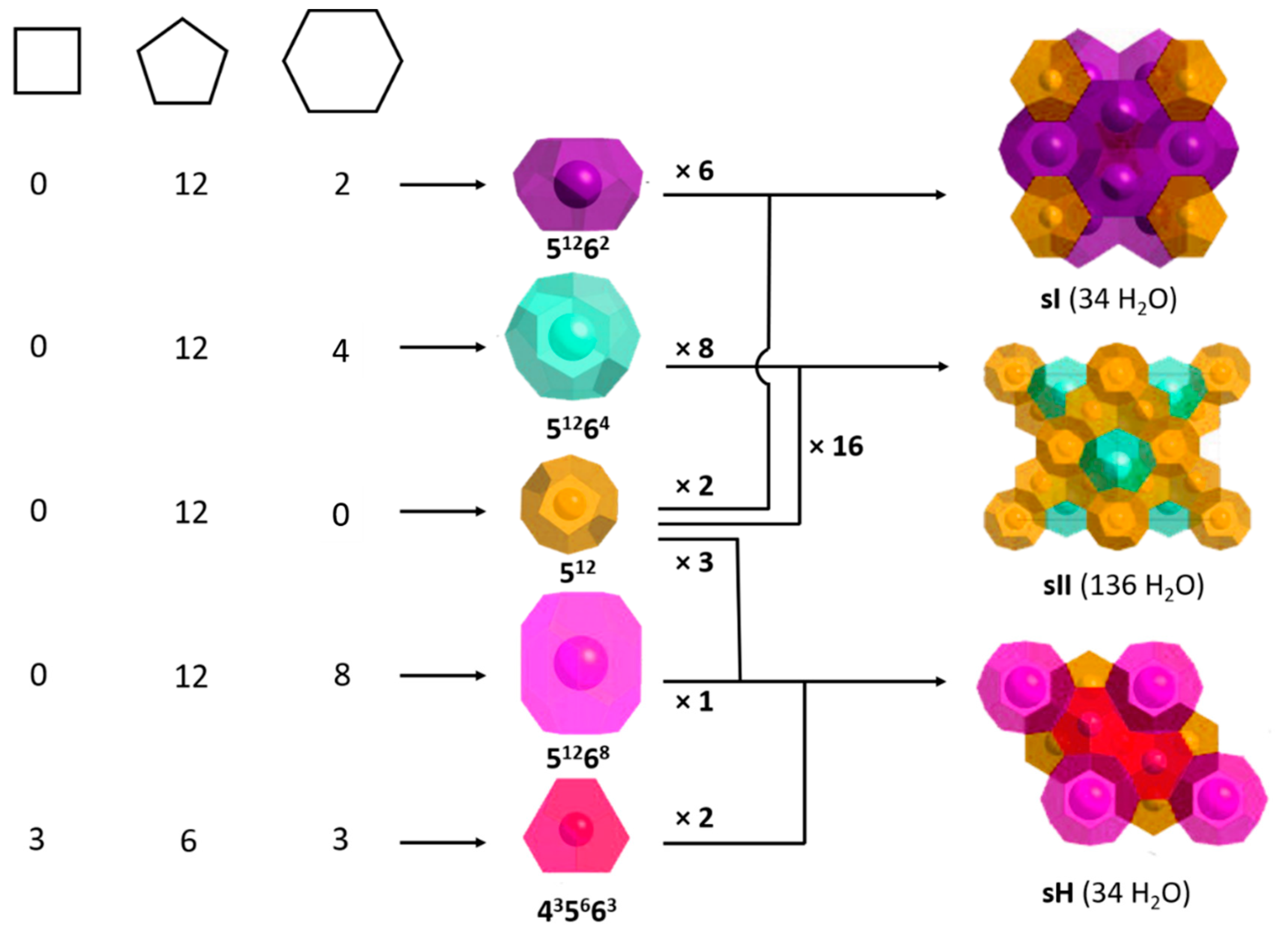
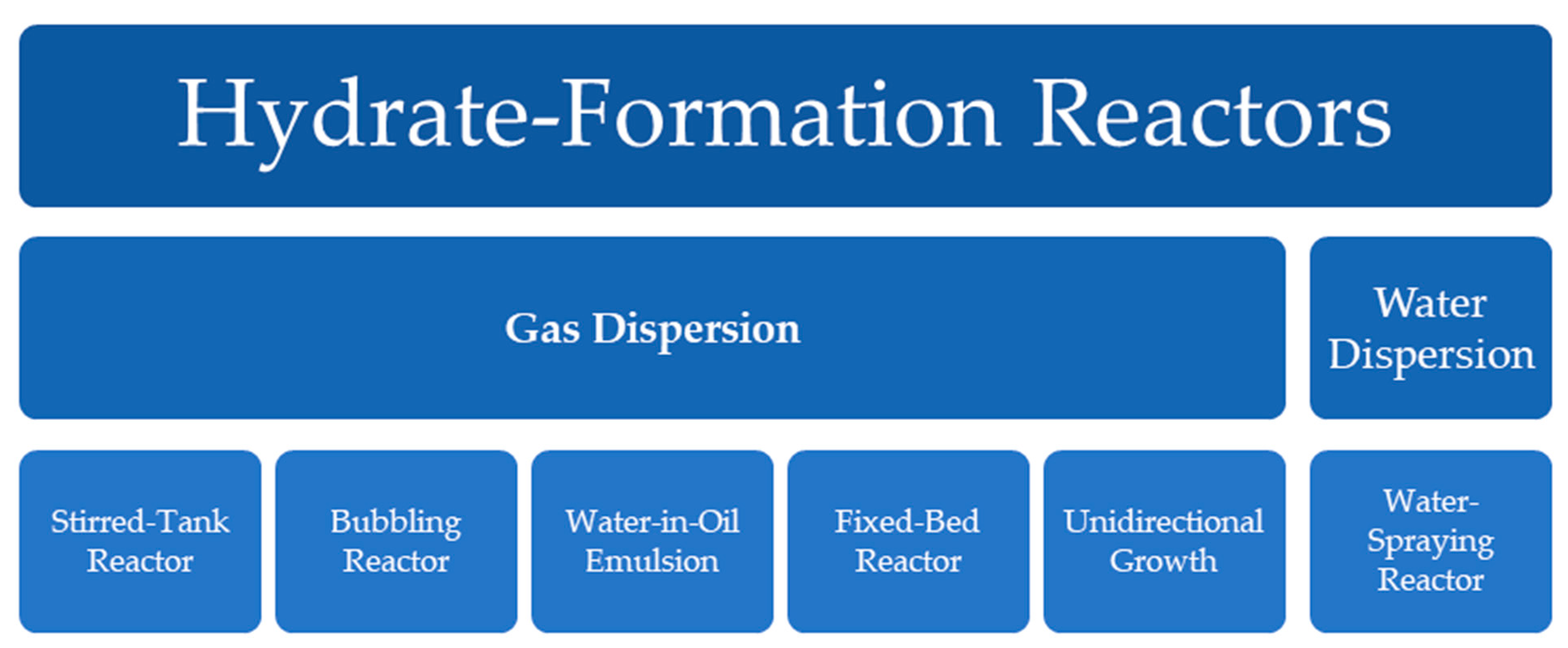
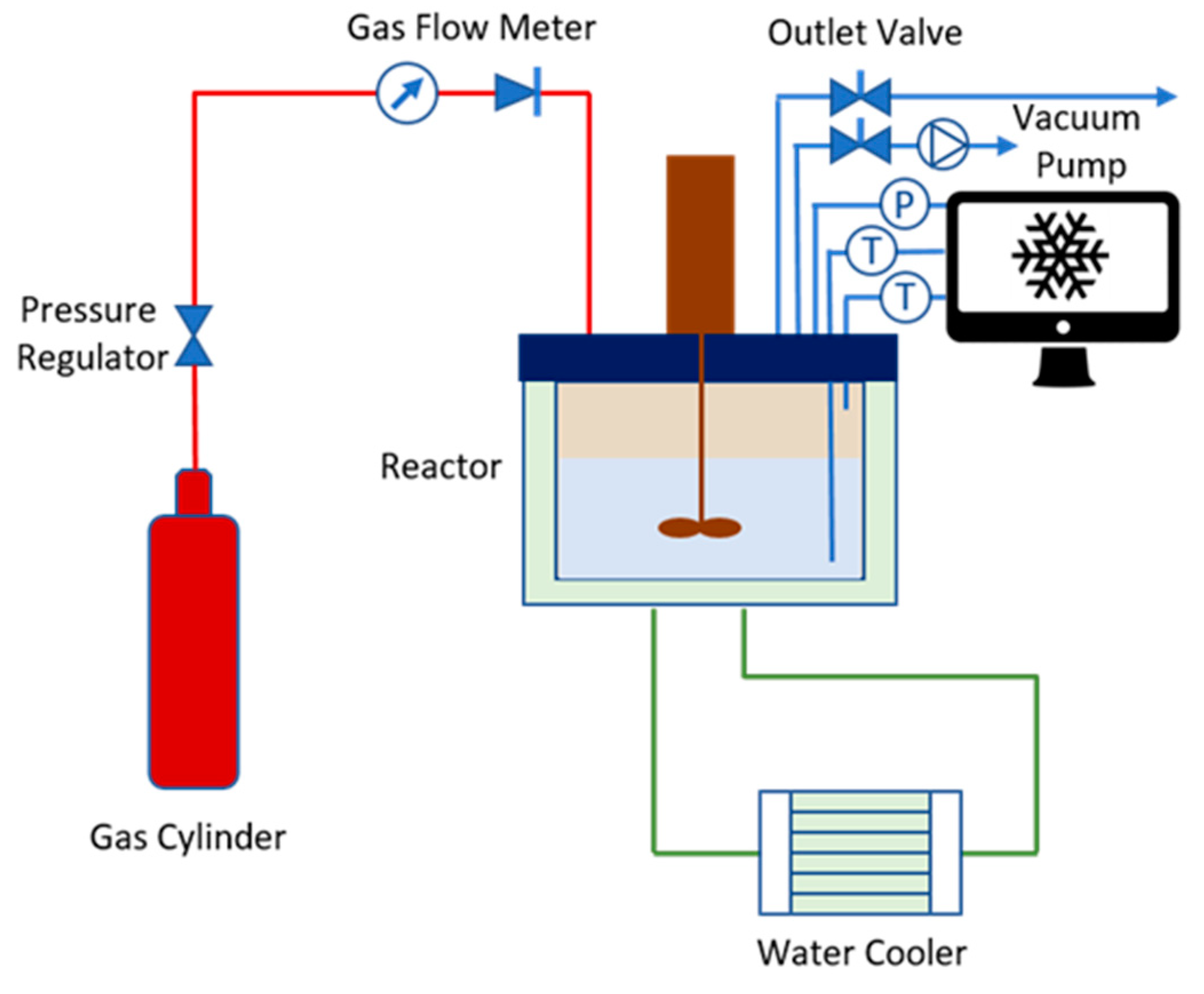
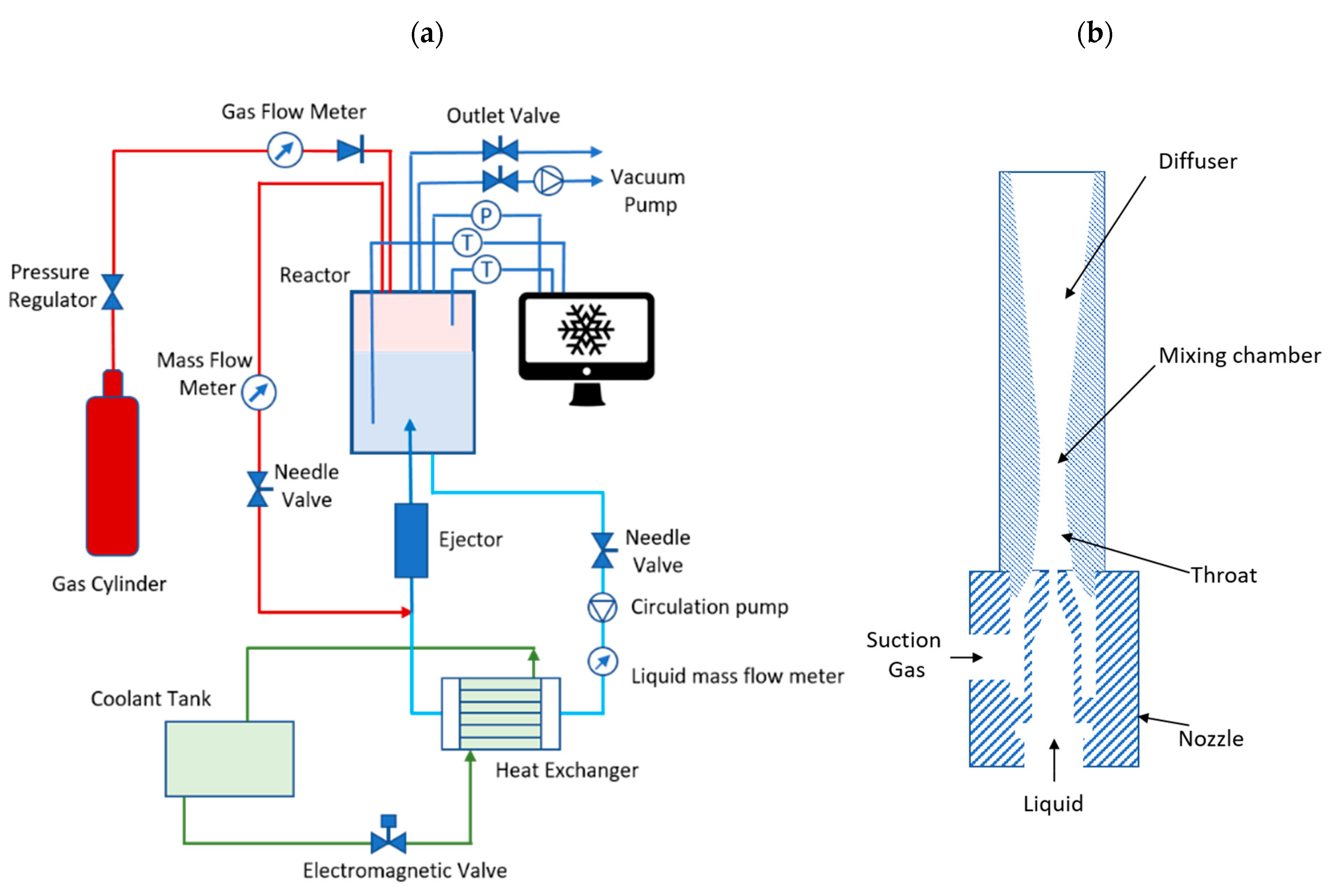


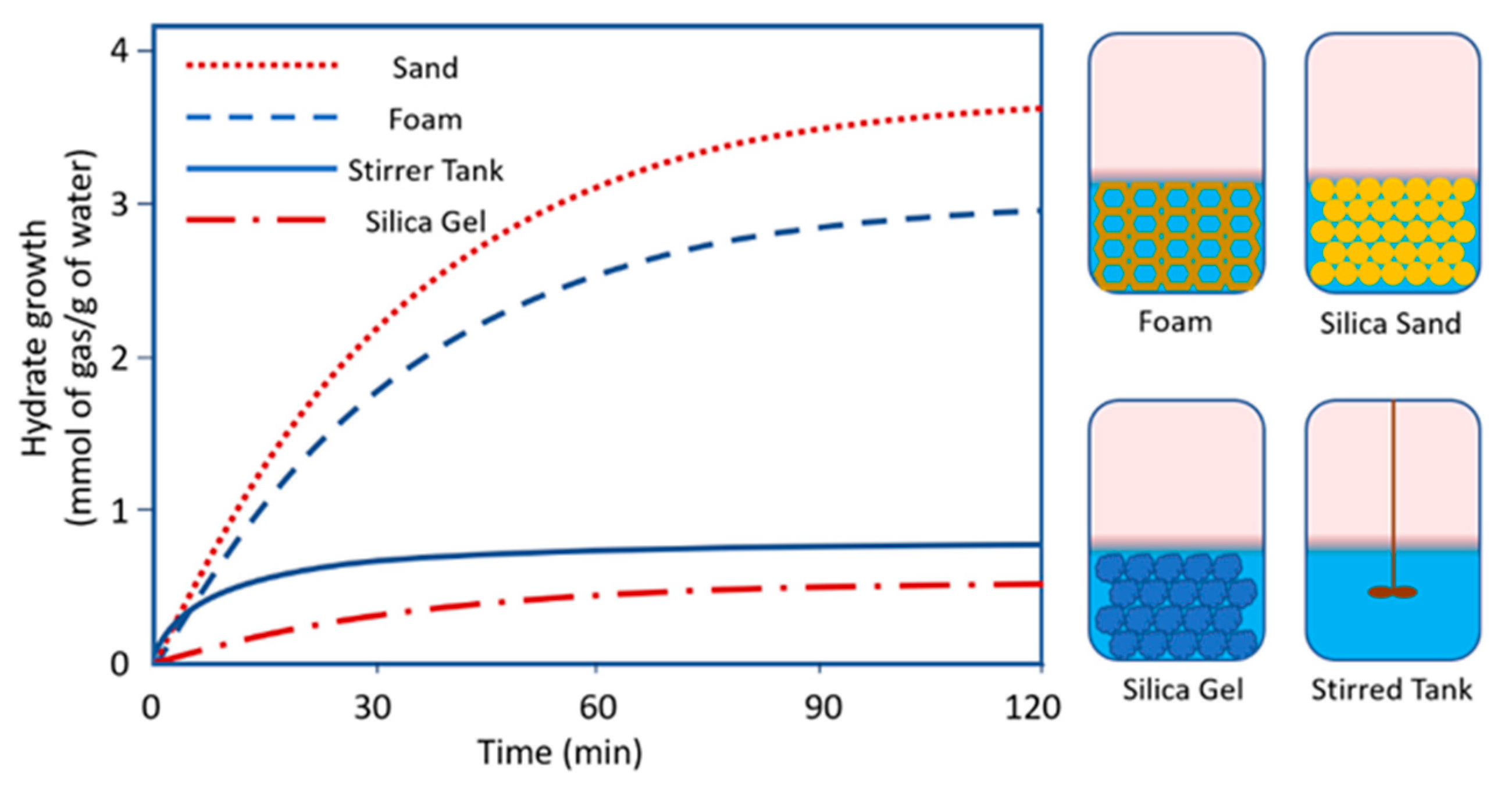

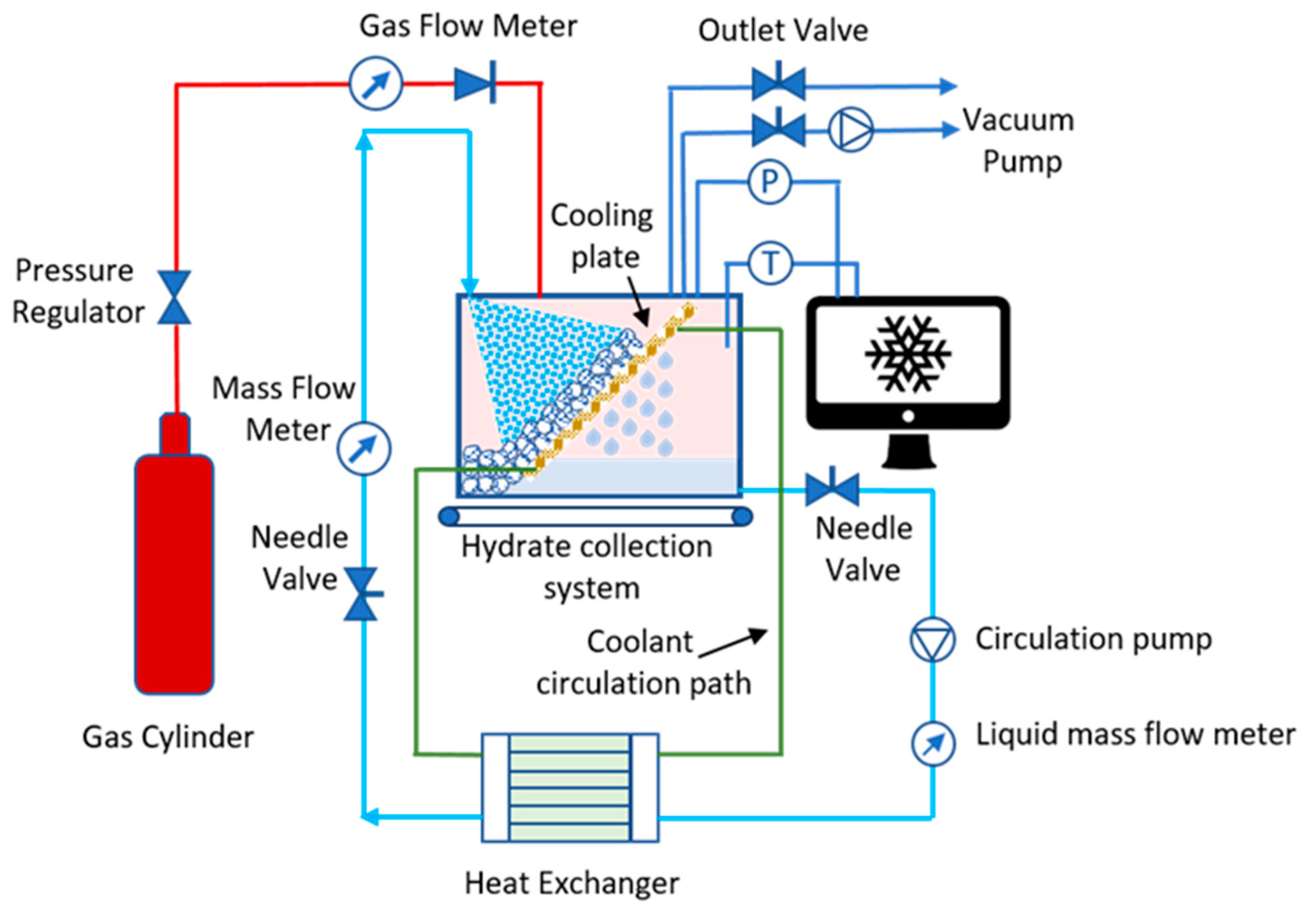
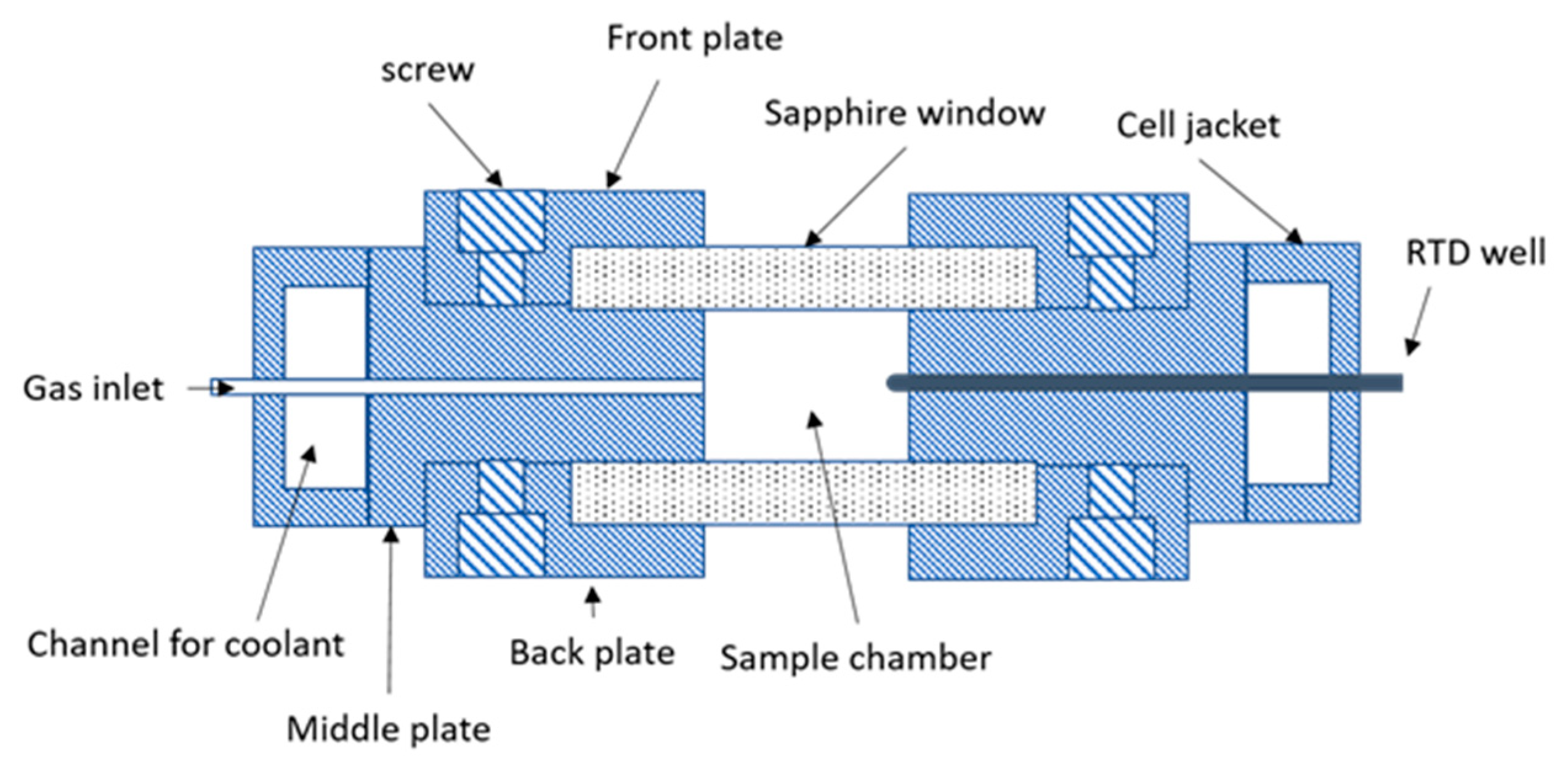
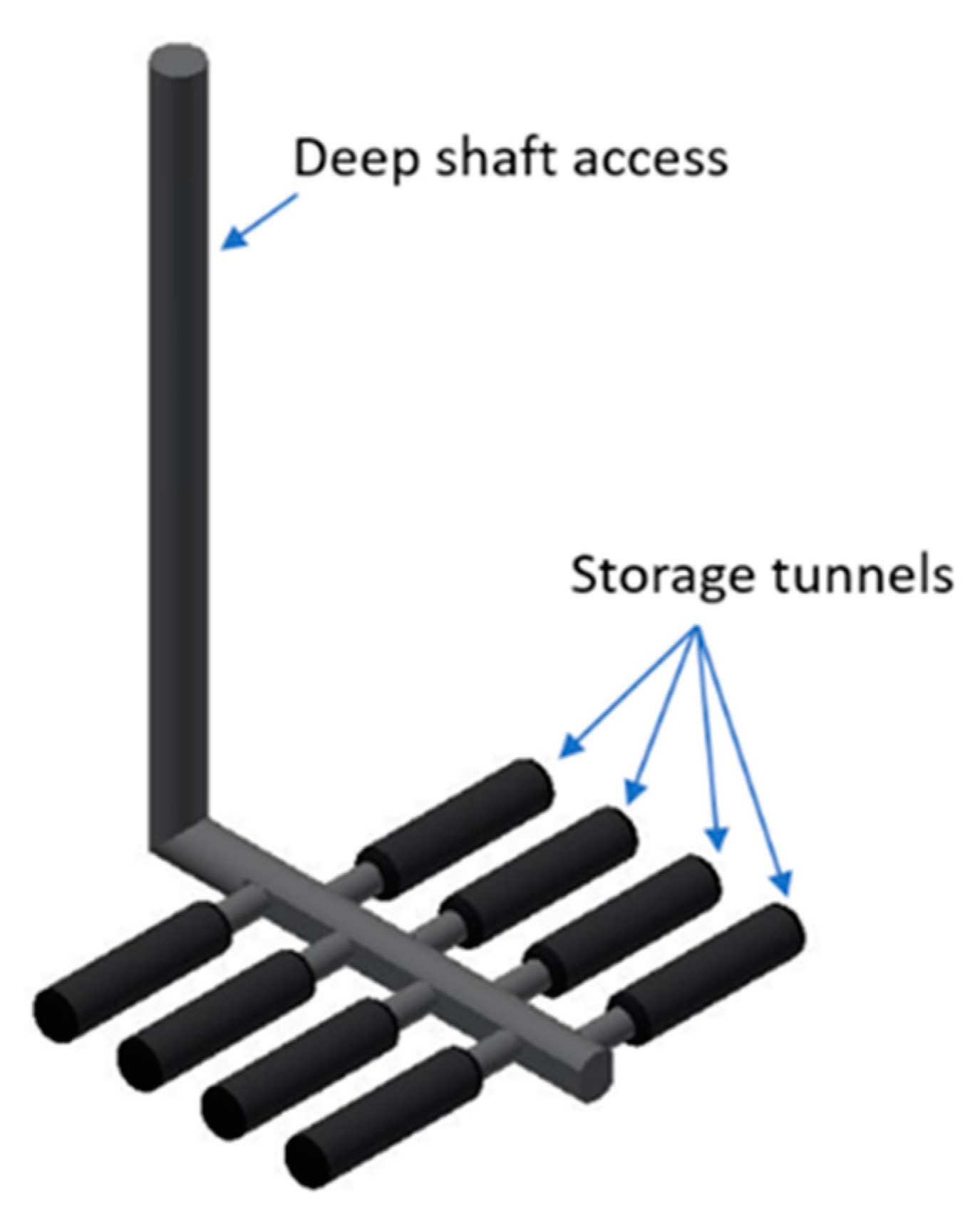
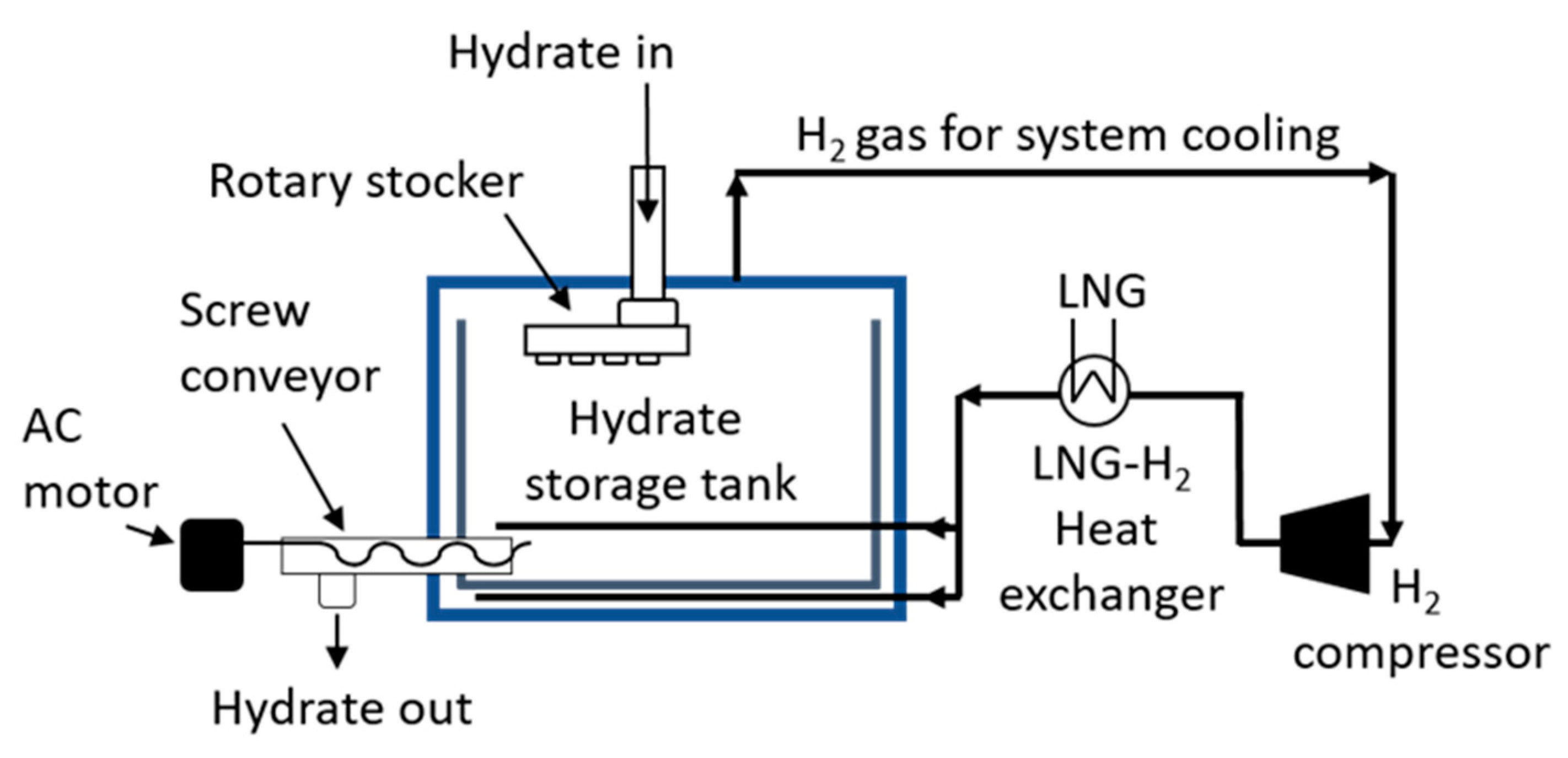
| Reactor | Features |
|---|---|
| Water dispersion |
|
| Water-Spraying Reactor |
|
| Gas dispersion |
|
| Stirred-Tank Reactor |
|
| Bubbling Reactor |
|
| Water-in-Oil Emulsion |
|
| Fixed-Bed Reactor |
|
| Unidirectional Growth |
|
Publisher’s Note: MDPI stays neutral with regard to jurisdictional claims in published maps and institutional affiliations. |
© 2021 by the authors. Licensee MDPI, Basel, Switzerland. This article is an open access article distributed under the terms and conditions of the Creative Commons Attribution (CC BY) license (http://creativecommons.org/licenses/by/4.0/).
Share and Cite
Ghaani, M.R.; Schicks, J.M.; English, N.J. A Review of Reactor Designs for Hydrogen Storage in Clathrate Hydrates. Appl. Sci. 2021, 11, 469. https://doi.org/10.3390/app11020469
Ghaani MR, Schicks JM, English NJ. A Review of Reactor Designs for Hydrogen Storage in Clathrate Hydrates. Applied Sciences. 2021; 11(2):469. https://doi.org/10.3390/app11020469
Chicago/Turabian StyleGhaani, Mohammad Reza, Judith M. Schicks, and Niall J. English. 2021. "A Review of Reactor Designs for Hydrogen Storage in Clathrate Hydrates" Applied Sciences 11, no. 2: 469. https://doi.org/10.3390/app11020469
APA StyleGhaani, M. R., Schicks, J. M., & English, N. J. (2021). A Review of Reactor Designs for Hydrogen Storage in Clathrate Hydrates. Applied Sciences, 11(2), 469. https://doi.org/10.3390/app11020469







